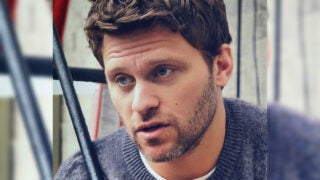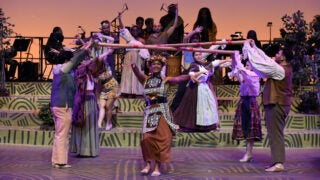USC filmmaker takes his shot at consequences of gun violence
Professor Jeremy Kagan reflects on upcoming film about the lives of three characters upended by a firearm
Televisions, movie screens and phones are filled with scenes of gunshots and gun deaths. The gunfight is as old as filmmaking, but those behind the camera seldom ask what are the consequences of gun violence. What is life like after you’ve been shot?
Jeremy Kagan, professor in Film & Television Production at the USC School of Cinematic Arts, is exploring that subject in SHOT, a dramatic feature film now in postproduction. Kagan, a longtime director, producer and writer, recently talked about the filmmaker’s role in covering social issues.
What’s the quick pitch on SHOT, your new film with Noah Wyle?
The film is about gun violence in America. Well, actually it is about three people whose lives are turned upside down by gun violence. I wanted to make a movie that touches people and, by doing this, contribute to the conversation about gun violence. By using a dramatic, suspenseful story, we want to get more people to talk about what it really means to get shot. Thirty people a day are killed by guns in this country and daily over 150 end up in emergency rooms. None of us want this.
In my film career, I have shot a lot of people. In the [opening of the] very first television show I directed, somebody got shot. In a Steven Spielberg series called Taken, the two-hour episode that I did also involved somebody getting shot. Seems I have been circling around this issue for decades.
What I realized is that I didn’t really know what getting shot is like. I think most of us who see movies and TV shows and even news reports don’t know, so I started doing my own research to find out what it actually means on the human level. What happens to somebody the minute they get shot? And that evolved over the years into an idea of actually having a visceral experience in the form of a dramatic movie that would be in real time when a character that you cared about gets shot.
The viewer experiences what that feels like during the first hour of the movie. In the medical profession, it’s known as the ‘golden hour’ and if you survive it, depending on the extent of damage, you generally live. But what is your life going to be like after that? That’s the second part of our film. So in the movie, we go through this golden hour with the character that Noah Wyle plays. And we also share the experience with his estranged wife, played by Sharon Leal of Dreamgirls, so we get to know what happens when you are close to someone who gets shot. For both of them, their world is changed forever.
At the same time, we’re telling the story of a bullied 16-year-old youth who lives in a disadvantaged neighborhood where guns often times are both more accessible and more employed. This person unwittingly becomes the perpetrator of the gun violence. We’re telling those two stories at the same time, in a multiscreen form.
What was your thought process in terms of balancing a social message and a compelling story?
Many of the movies I have made have dealt with social issues. That’s always been a motivation for me. I became a filmmaker inspired by the work of Sergei Eisenstein, a Russian filmmaker whose early work was all about shifting political awareness, getting people to take action against the dominating elite who had no right to be in their position to suppress and oppress masses of people. His movies stimulated me and made me question why I make films, and since then I have thought of myself, and still do, as a political, social filmmaker.
Does an artist have to take a particular approach to social issue films?
What I’ve learned — and still am learning even in the process of making this film — is that the power of a story is the fundamental element in shifting awareness. And it is the identification with characters and the empathy that you have toward them that becomes the heart of the piece. That must be your approach. You have to have a story that is compelling; you have to have characters that we care about. That caring generates our wanting to know what’s going to happen to them. And that gets us involved and motivates us to potential action as well. And we may then want to be part of the solution to the problem brought up in the movie.
What aspect did you find yourself focusing on?
In the editing room, what has been moving me is the relationships of our characters, and I am rooting for them when this unexpected catastrophe hits them. So it is the humanity, not the political, that is inspiring me. This actually became clearer in how the script developed. The initial draft by a former SCA student Will Lamborn, based on a story of mine, focused on the narrative facts, and he did a good job. Then my writer, Anneke Campbell, added her gifted voice to creating a different depth in the characters that allowed for greater identification.
Hopefully the viewers will go through the rollercoaster ride of what getting shot means for these characters, people that they care about, and then they will say, “It’s just too easy to be able to get guns in our society, and we can do something about that.”
On a broad level, what can film do that other mediums or media can’t do?
Film is immersive in ways different from other media in that it actually combines all media — visual and aural — and there’s a collectivity about it. Yes, you can watch a movie on your iPhone or on your television alone, so that is a shift, but even then there’s a knowledge that other people are watching it, too. Think about most conversations when you get together with others — we talk about what we watch.
The other element is urgency. Yes, you can stop it on your machines if you’re watching it at home and you can run it back and forth; you have much more control than before. But film really does operate in time so the immersiveness includes the urgency of time — that is different from any other media. It’s the cinema’s aesthetics; the control of time is an aspect that makes it different.
As opposed to a novel?
Yes, where you can read at your own pace. And of course in other media like the graphic arts, you control how much time you spend.
So the filmmaker has control over time. The cinematic storyteller has control of the time. And we are working specifically with time in SHOT. What is potentially compelling about this movie is that we’ve made a choice, and it’s an experimental choice — we’ll see how it works — to do something in a way that is a reversal of cinematic expectancy. One of the qualities of cinema is that you can cut in time; you can jump time from here to there, and we accept that as the nature of moviemaking. In this particular movie — for almost an hour — we are intentionally not doing that. We are telling our story in real time.
Yes, because it’s the nature of a gunshot.
Well, it’s the nature of what I want myself, and others, to experience. This guy gets shot on a street while walking with his wife, he goes down on that street and then it takes almost seven minutes for an ambulance to arrive. We don’t cut away from this. We never leave him. What do you do in those anxious, painful minutes? How do you feel? What goes on in your mind?
SHOT seems like a natural extension of your body of work.
I’ve thought about this a lot in the last months. There’s a circular nature, or almost a spiral nature, leading me to this point in both the form and content of my work. In cinematic form, the use of multiple screens has been part of my visual imagery for decades starting with [the HBO film] Conspiracy: The Trial of the Chicago 8 and used throughout a 10-part series I produced and directed called Freedom Files. And as to the content of my movies, I see I am continuously dealing with the social issues of violence employed to solve problems, versus understanding, and tolerance and redemption.



